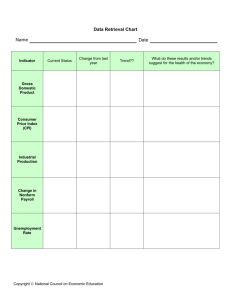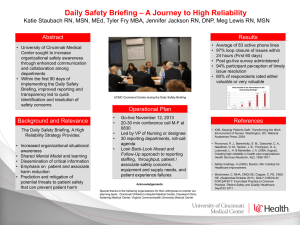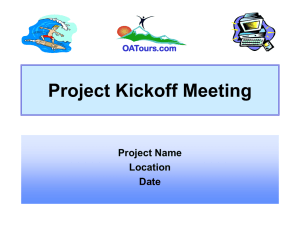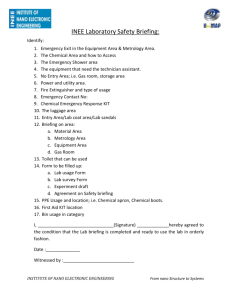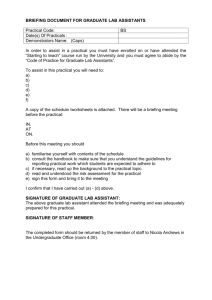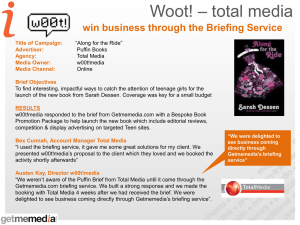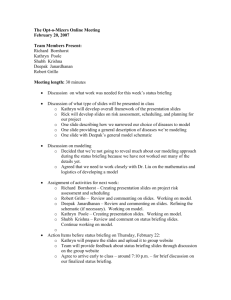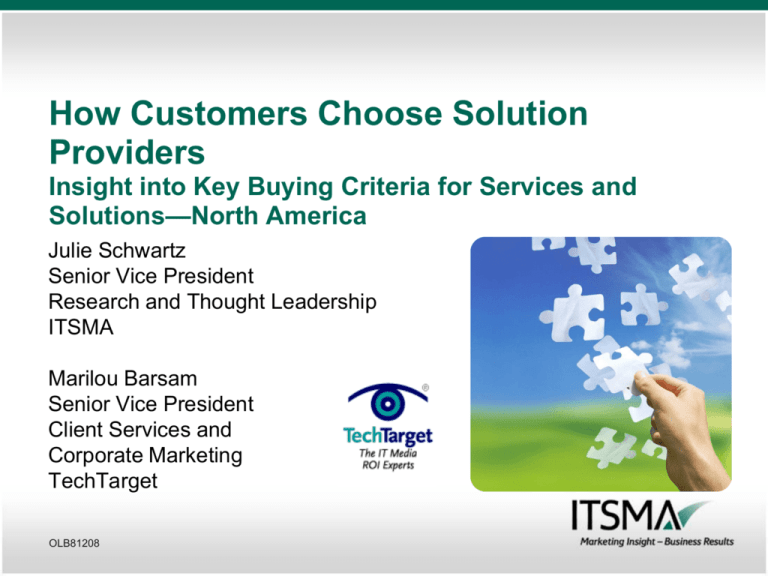
How Customers Choose Solution
Providers
Insight into Key Buying Criteria for Services and
Solutions—North America
Julie Schwartz
Senior Vice President
Research and Thought Leadership
ITSMA
Marilou Barsam
Senior Vice President
Client Services and
Corporate Marketing
TechTarget
OLB81208
Successful companies map their marketing
strategy and tactics to the buying process
Relationship
Stages
Buying
Process
OLB081208
Awareness
Interest
Confidence
Loyalty
Search
Alternative
Evaluation
Selection and
Purchase
Post-Purchase
Evaluation
Clarify objectives
and solution
specifications
Identify
alternatives
(short list)
Solicit
proposals
Evaluate
alternatives
Select the
provider
Negotiate
the contract
Ultimate
sign-off
Evaluate
satisfaction
Measure value
delivered
ITSMA Online Briefing
© 2008 ITSMA. All Rights Reserved. 2
ITSMA has come to recognize that there is another
buying process stage that is often overlooked
Relationship
Stages
Epiphany
Need
Recognition
Buying
Process
OLB081208
Explore the
possibilities
Identify a need
or opportunity
Awareness
Search
Clarify
objectives
and solution
specifications
Identify
alternatives
(short list)
Interest
Confidence
Alternative
Evaluation
Selection and
Purchase
Solicit
proposals
Evaluate
alternatives
Select the
provider
Negotiate
the
contract
Ultimate
sign-off
ITSMA Online Briefing
Loyalty
Post-Purchase
Evaluation
Evaluate
satisfaction
Measure
value
delivered
© 2008 ITSMA. All Rights Reserved. 3
IT Pros are Always Researching
IT Buyers Use Multiple Content Types at
Different Stages of Buying Cycle
Awareness
Consideration
Decision
Vendor demos
Trial software
IT vendors
Live events
Virtual trade shows
Search engines
Published research
Case studies
White papers
Webcasts
IT publishers
IT videos
Industry magazines
IT newsletters
IT blogs
Widgets
Podcasts
IT wikis
Q4 2007 TechTarget
and CMO Council
Technology Buying
and Media
Consumption
Survey, Report 4
IT Buyers Use Multiple Content Types at
Different Stages of Buying Cycle
Awareness
Consideration
Decision
Vendor demos
Trial software
IT vendors
Live events
…used at different stages of the buying cycle
Virtual trade shows
Search engines
Published research
…offer more choice and broaden reach
Case studies
White
topapers
strengthen online branding opportunity
Webcasts
IT publishers
IT videos
Multiple content types
Industry magazines
IT newsletters
IT blogs
Widgets
Podcasts
IT wikis
Q4 2007 TechTarget
and CMO Council
Technology Buying
and Media
Consumption
Survey, Report 4
Today’s Presentation
Results from the ITSMA-TechTarget How Customers
Choose Survey
Buying behavior at three stages
of the Buying Process:
Epiphany
Need
Recognition
OLB081208
Awareness
Search
ITSMA Online Briefing
Interest
Alternative
Evaluation
© 2008 ITSMA. All Rights Reserved. 7
Research Methodology
Sample sources:
TechTarget IT Research Panel
ITSMA in-house list
OLB81208
What companies were included in our sample?
What is your company’s primary business?
% of Respondents (N=216)
17
Approximately, what is your company’s
annual revenue, is it ___?
% of Respondents (N=216)
Other
20
18
Communications
19
Public Sector
23
Financial Services
23
Manufacturing
17
20
19
10
$200– $500–
499M 999M
$1–
4.9B
$5–
9.9B
13
$10–
20B
Over
$20B
Note: Other includes: Healthcare (7), Retail (3), Wholesale
Distribution (3), Education (3), Legal (2), Consulting (2), IT
Services (2), Multi-industry, Energy, Non-profit Ministry, IT
Outsourcing, Distribution, Transportation Services, Information
Management, Oil & Gas, Utilities, Marketing, Wholesale,
Construction, Non-profit, Defense Contractor, Biotechnology
Source: ITSMA, How Customers Choose Study, North America, 2008
OLB081208
ITSMA Online Briefing
© 2008 ITSMA. All Rights Reserved. 9
Who did we speak to?
Are you an business or IT professional?
% of Respondents (N=216)
What is your job title?
% of Respondents (N=216)
C-level, GM,
President (15%)
Business
(35%)
Director (40%)
IT (65%)
VP/Assistant
VP (17%)
Manager (28%)
Source: ITSMA, How Customers Choose Study, North America, 2008
OLB081208
ITSMA Online Briefing
© 2008 ITSMA. All Rights Reserved. 10
How are they approaching investments given the
current economic climate?
Which of the following is more important
to you and your company in the current
economic environment?
% of Respondents (N=105)
Which would you say is driving your
technology investment focus right now?
% of Respondents (N=214)
Other (9%)
Reducing
costs
(46%)
Increasing
revenue or
sales (54%)
Cost
reduction
(35%)
Adding new
functionality and
capabilities (56%)
Source: ITSMA, How Customers Choose Study, North America, 2008
OLB081208
ITSMA Online Briefing
© 2008 ITSMA. All Rights Reserved. 11
74% are either increasing or maintaining their IT
budgets
What is happening to your spending for technology-enabled business
initiatives so far in 2008?
% of Respondents (N=212)
Increase
(35%)
Stay
the
same
(39%)
Decrease
(25%)
Will it increase by more
or less than 10%?
% of Respondents (N=75)
Will it decrease by more
or less than 10%?
% of Respondents (N=53)
68
Less
57
Less
32
More
43
More
Source: ITSMA, How Customers Choose Study, North America, 2008
OLB081208
ITSMA Online Briefing
© 2008 ITSMA. All Rights Reserved. 12
Create Demand: Build and nurture relationships
before your potential customer is ready to buy
Relationship
Stages
Epiphany
Need
Recognition
Buying
Process
OLB081208
Explore the
possibilities
Identify a need
or opportunity
Awareness
Search
Clarify
objectives
and solution
specifications
Identify
alternatives
(short list)
Interest
Confidence
Alternative
Evaluation
Selection and
Purchase
Solicit
proposals
Evaluate
alternatives
Select the
provider
Negotiate
the
contract
Ultimate
sign-off
ITSMA Online Briefing
Loyalty
Post-Purchase
Evaluation
Evaluate
satisfaction
Measure
value
delivered
© 2008 ITSMA. All Rights Reserved. 13
Relationship
Stages
Epiphany
Awareness
Interest
Confidence
Loyalty
Buyers perceive solution providers to be moderately
helpful when it comes to identifying business problems
How helpful are solution providers in working with you and your organization
to identify and clarify business problems or opportunities?
% of Respondents (N=199)
Not at all helpful = 1
2
2
24
3
38
4
Very helpful = 5
Mean Rating: 3.1
32
5
Note: Mean rating based on a 5-point scale where 1=not at all helpful and 5=very helpful.
Source: ITSMA, How Customers Choose Study, North America, 2008
OLB081208
ITSMA Online Briefing
© 2008 ITSMA. All Rights Reserved. 14
Relationship
Stages
Epiphany
Awareness
Interest
Confidence
Loyalty
Likewise, there is room for improvement when it
comes to bringing new ideas to potential clients
How helpful are they in bringing you new ideas and showing you the
possibilities to solve your business issues?
% of Respondents (N=199)
Not at all helpful = 1
3
2
18
3
38
4
Very helpful = 5
Mean Rating: 3.2
36
6
Note: Mean rating based on a 5-point scale where 1=not at all helpful and 5=very helpful.
Source: ITSMA, How Customers Choose Study, North America, 2008
OLB081208
ITSMA Online Briefing
© 2008 ITSMA. All Rights Reserved. 15
Topical InfoCenter
Unified Communications
Thought Leadership Example:
• TechTarget editorial content
on the left side
• 100% share of voice for
sponsor surrounding the
content
• 10 content links along the
right side of the editorial
content
• Banners
E-Guide—
Storage Virtualization
Thought Leadership Example:
• Four articles on Storage
Virtualization produced in
rich-media format
• Up to four pages for
sponsor messaging
integrated with editorial
content, including:
advertisements, resource
links, and other information
about sponsor’s company
or products.
Relationship
Stages
Epiphany
Awareness
Interest
Confidence
Loyalty
Buyers are looking for thought leadership that is
proven, practical, and relevant
In your view, how much does each of the following contribute to compelling,
high quality thought leadership? Mean Rating (N~185)
Validity: Proving the solution is effective
4.3
Practicality: Demonstrating a solution can be implemented
4.2
Relevance: Meeting a critical and market need
4.2
Clarity: Making a clear argument with words and concepts
that are easy to understand
3.8
Focus: Having a single fundamental message
3.4
Rigor: Having tight consistent ideas and language
3.4
Novelty: Coming up with a unique diagnosis or solution
3.3
Note: Mean rating based on a 5-point scale where 1=not at all a factor and 5=a major factor.
Source: ITSMA, How Customers Choose Study, North America, 2008, adapted from the Bloom Group, 2007
OLB081208
ITSMA Online Briefing
© 2008 ITSMA. All Rights Reserved. 18
Vendor Case Study
• Title: NASA Federal Credit
Union Discovers Online
Data Backup
• Topic: Backup/ Recovery
• Promotion Site:
SearchStorage.com
• Sponsor: EVault, Inc.
• Best Practice: Marketed
well-known partner
• Benefit-Oriented
positioning paid off
• Performed 29% better than
case studies promoted on
site during same period
Third-Party Case Study
• Title: Forrester Consulting Case
Study on Database Security &
Compliance
• Sponsor: Guardium
• Topic: Risk Management
• Promotion Site:
SearchSecurity.com
• Best Practice:
Marketed third-party
endorsement
• Third-Party association
delivers results
• Performed 42% better
than all white papers
promoted on site
during same period!
Relationship
Stages
Epiphany
Awareness
Interest
Confidence
Loyalty
The most valuable relationship building activities are those
that facilitate the exchange of ideas and foster community
Which three solution provider relationship-building programs do you think provide the
greatest value to you? % of Respondents (N=184)
User groups
53
Private briefings
40
Executive-level business events (e.g., seminars, meetings)
35
Client reference programs
31
Customer advisory councils
28
Collaborative thought leadership development
Dedicated “microsite” for your company with information about their project work and
thought leadership
Account-based or one-to-one marketing programs
24
19
17
Loyalty incentives (e.g., training credits, discounts)
12
Customer satisfaction and loyalty surveys
11
Online communities/social networking that the solution provider facilitates
9
Social or recreational activities (e.g., golf outings, dinners)
Joint PR/Advertising/co-branding
Blogging
9
4
2
Note: Up to three responses allowed.
Source: ITSMA, How Customers Choose Study, North America, 2008
OLB081208
ITSMA Online Briefing
© 2008 ITSMA. All Rights Reserved. 21
Huge, Active Online Communities
Generate Leads: Make it easy for potential buyers
to find you
Relationship
Stages
Epiphany
Need
Recognition
Buying
Process
OLB081208
Explore the
possibilities
Identify a need
or opportunity
Awareness
Search
Clarify
objectives
and solution
specifications
Identify
alternatives
(short list)
Interest
Confidence
Alternative
Evaluation
Selection and
Purchase
Solicit
proposals
Evaluate
alternatives
Select the
provider
Negotiate
the
contract
Ultimate
sign-off
ITSMA Online Briefing
Loyalty
Post-Purchase
Evaluation
Evaluate
satisfaction
Measure
value
delivered
© 2008 ITSMA. All Rights Reserved. 23
Relationship
Stages
Epiphany
Awareness
Interest
Confidence
Loyalty
IT buyers are actively researching new solution
providers
What percentage of the time would you say you do research and find
appropriate solution providers versus they contact you first?
Mean % of the Time (N=191)
The solution provider
contacts me first (31%)
I do the research and
find the appropriate
solution providers (69%)
Source: ITSMA, How Customers Choose Study, North America, 2008
OLB081208
ITSMA Online Briefing
© 2008 ITSMA. All Rights Reserved. 24
Relationship
Stages
Epiphany
Awareness
Interest
Confidence
Loyalty
Professional peers are the most important “search
tool” followed by online sources
When you have a business problem, what are the first three steps you take to
identify alternative solutions?
% of Respondents (N=194)
80
Speak to my professional peers
55
Look online including, IT publisher Websites, company websites, blogs, etc.
40
Speak to your existing hardware and software vendors
36
Speak to or check publications of industry analysts (e.g., Gartner, IDC, AMR)
26
Get advice from consultants
16
Read business and trade publications
6
Speak to or check publications of financial analysts (e.g., Merrill Lynch or Goldman)
Respond to unsolicited emails and cold calls from consultants or solution providers
2
Pay closer attention to advertisements
2
Other 1
Note: Up to three responses allowed.
Source: ITSMA, How Customers Choose Study, North America, 2008
OLB081208
ITSMA Online Briefing
© 2008 ITSMA. All Rights Reserved. 25
Relationship
Stages
Epiphany
Awareness
Interest
Confidence
Loyalty
Buyers turn to both informal and formal peer
networks
% of Responses (N=197)
Speak to peers who participate
in exclusive councils or
communities you belong to
(25%)
Speak to colleagues in
your company for
referrals (40%)
Speak to colleagues at other
companies for referrals
(35%)
Source: ITSMA, How Customers Choose Study, North America, 2008
OLB081208
ITSMA Online Briefing
© 2008 ITSMA. All Rights Reserved. 26
Relationship
Stages
Epiphany
Awareness
Interest
Confidence
Loyalty
Search methods vary by role, so adapt your
marketing to your target audience
When you have a business problem, what are the first three steps you take to
identify alternative solutions? % of Respondents
80
80
Speak to my professional peers
66 *
Look online including, IT publisher Websites, company websites, blogs, etc.
38 *
38
43
Speak to your existing hardware and software vendors
40
Speak to or check publications of industry analysts
30
19 *
Get advice from consultants
Read business and trade publications
Speak to or check publications of financial analysts
Respond to unsolicited emails and cold calls from consultant
Pay closer attention to advertisements
38 *
22 *
8*
3*
11*
3
1
2
1
IT (N=120)
Business (N=74)
Notes: Mean rating based on a 5-point scale where 1=not at all effective and 5=very effective.
* Indicates a statistically significant difference.
Source: ITSMA, How Customers Choose Study, North America, 2008
OLB081208
ITSMA Online Briefing
© 2008 ITSMA. All Rights Reserved. 27
What should be important to IT marketers?
33.2%
Search Engines
30.6%
31.0%
16.9%
IT Publishers-Websites
15.0%
17.8%
8.3%
Conferences/Seminars/
Tradeshows
6.8%
Q4
Q3
Q2
7.3%
8.2%
IT Vendor Websites
10.1%
9.5%
6.7%
Published Research
8.2%
6.8%
Q: Which is the single most effective
information source?
5.7%
IT Publishers-Magazines
5.9%
5.3%
Q4 2007 TechTarget and CMO Council
Technology Buying and Media Consumption Survey, Report 4
Relationship
Stages
Epiphany
Awareness
Interest
Confidence
Loyalty
Web 2.0 is slowly gaining momentum, yet
resistance to adoption persists
Are you using or have you used any new Web 2.0 or social media tools such
as blogs or social networks to seek out information on possible solutions?
% of Respondents (N=202)
Don’t know (4%)
Yes (37%)
(Primarily blogs)
No (59%)
(Why not? not reliable,
not trustworthy, time
consuming, content not
valuable, no need,
against organization
policy, security issues)
Source: ITSMA, How Customers Choose Study, North America, 2008
OLB081208
ITSMA Online Briefing
© 2008 ITSMA. All Rights Reserved. 29
Relationship
Stages
Epiphany
Awareness
Interest
Confidence
Loyalty
The marketing vehicles that are most effective are
content rich and highlight problem solving
Which types of marketing vehicles do you believe are most effective in getting
your attention and encouraging you to learn more? Mean Rating (N~185)
Case studies describing successful customer solution implementations
Article in the business or industry trade press
Speech or presentation at a conference or trade show
Invitation to a seminar or workshop
White paper offered on the Internet
Search engine hits when doing research or surfing the Web
Invitation to a Webinar
Conference sponsorship
Electronic newsletter from the service firm
Direct mail brochure
Online advertisement
Email from a sales representative from the service firm
TV or print advertisement
Phone call from a sales representative from the service firm
Hospitality programs such as dinner or golf outings
Solution provider's blog
Sporting or cultural event sponsorship
3.6
3.5
3.5
3.3
3.3
3.2
3.1
2.8
2.6
2.4
2.4
2.4
2.3
2.3
2.3
2.1
2.0
Note: Mean rating based on a 5-point scale where 1=not at all effective and 5=very effective.
Source: ITSMA, How Customers Choose Study, North America, 2008
OLB081208
ITSMA Online Briefing
© 2008 ITSMA. All Rights Reserved. 30
Provide Proof: Buyers are looking for a proven
track record
Relationship
Stages
Epiphany
Need
Recognition
Buying
Process
OLB081208
Explore the
possibilities
Identify a need
or opportunity
Awareness
Search
Clarify
objectives
and solution
specifications
Identify
alternatives
(short list)
Interest
Confidence
Alternative
Evaluation
Selection and
Purchase
Solicit
proposals
Evaluate
alternatives
Select the
provider
Negotiate
the
contract
Ultimate
sign-off
ITSMA Online Briefing
Loyalty
Post-Purchase
Evaluation
Evaluate
satisfaction
Measure
value
delivered
© 2008 ITSMA. All Rights Reserved. 31
Relationship
Stages
Epiphany
Awareness
Interest
Confidence
Loyalty
When evaluating the solution, feature-function
and ROI win
Once you have created your short list and you are evaluating alternative
business solutions, which one factor is most important to your decision?
% of Respondents (N=193)
ROI (The calculated Return on Investment for the solution)
or cost/benefit analysis
34
Features and functionality of the solution
26
4.3
4.3
4.1
11
TCO (The total cost of ownership)
Mean
Rating
The price
8
4.0
Soft benefits such as customer satisfaction,
brand equity, service quality
8
3.8
5
The length of time required to implement and realize benefits
Reduced risk of implementation
Other
4.0
4
3.9
3
NA
Note: Mean rating based on a 5-point scale where 1=not at all important and 5=very important.
Source: ITSMA, How Customers Choose Study, North America, 2008
OLB081208
ITSMA Online Briefing
© 2008 ITSMA. All Rights Reserved. 32
Relationship
Stages
Epiphany
Awareness
Interest
Confidence
Loyalty
When evaluating providers, an impeccable
reputation tops the list
When evaluating alternatives and selecting the company to help you
implement the solution, which one factor is most important to your decision?
% of Respondents (N=188)
Mean
Rating
19
A proven track record
16
People and an organization you can trust
14
Knowledge transfer to your staff
11
Knowledge and understanding of your unique business issues
10
Available resources to meet deadlines and speed time to market
7
Knowledge and understanding of your industry
4.3
4.4
4.2
4.1
4.3
4.0
Previous experience with your company
5
3.7
Highly-tailored, customized solutions
5
3.3
Thought leadership on the application of technology to solve business problems
5
3.8
4
A collaborative work style
3
A low price
Other
1
4.0
3.5
NA
Note: Mean rating based on a 5-point scale where 1=not at all important and 5=very important.
Source: ITSMA, How Customers Choose Study, North America, 2008
OLB081208
ITSMA Online Briefing
© 2008 ITSMA. All Rights Reserved. 33
Relationship
Stages
Epiphany
Awareness
Interest
Confidence
Loyalty
Knowledge and experience with the technology
and industry are important, but not sufficient
Which of these would you say gives you more comfort that a solution provider
can deliver? Knowledge and experience with…
% of Respondents (N=189)
Your industry (e.g., banking or
healthcare) (11%)
The technology (35%)
The business process
(26%)
Your company and your
business (28%)
Source: ITSMA, How Customers Choose Study, North America, 2008
OLB081208
ITSMA Online Briefing
© 2008 ITSMA. All Rights Reserved. 34
Marketer Challenge: What content types and
specific media will be most effective to reach
buyers at each stage of the buying cycle?
First step—What is your
primary challenge?
– Attracting prospects from
competition? Capturing share
in a subsegment? Finding best
leads in a booming market?
Based on that—Which
decision-making stage and
content to focus investment
OLB081208
ITSMA Online Briefing
© 2008 ITSMA. All Rights Reserved. 35
Online, prospects enter, exit, progress with
different needs. Information need =
opportunity
Match content type and content topic to
decision making stage
Content Topic
Awareness/
Solving IT Problems
(editorial content)
Downloading
Trialware and
Demos
Media Type
Attending
Webcasts and
Podcasts
Downloading
and Reading
White Papers
Consideration/
Technical Information
(vendor-specific)
Decision/
Solution Information (proof
points/case studies)
Case Study: Smurfit-Stone (#247 on the
Fortune 500), LAN Specialist Researching
IT Solutions
Value of multiple content topics and assets extends to developing a
prospect online
Content Topic
Awareness/
Solving IT Problems
(editorial content)
Downloading
Trialware and
Demos
Media Type
Attending
Webcasts and
Podcasts
Downloading
and Reading
White Papers
“Overview doc,”
March 2006
Editorial/expert
Consideration/
Technical Information
(vendor-specific)
“Tech
Description,”
April 2006
Vendor
focus/overview
Decision/
Solution Information (proof
points/case studies)
“Service Offering
Description,”
May 2006
Case study
Recommendations: Map your marketing strategy
and tactics to the buyer’s process
Epiphany
Need Recognition:
Create Demand
Awareness
Search:
Generate Leads
Interest
Evaluation:
Provide Proof Points
Build relationships
based on thought
leadership and
community
Show the
possibilities
Align your content to
the buying stage
Ease the burden;
make the buyer’s
search effortless
Emphasize word of
mouth and online
marketing
Rely on pull
marketing, but don’t
completely abandon
push marketing
Show, don’t tell
Demonstrate validity
and practicality
through case studies
Personalize and
customize: Know the
buyer’s unique
business issues
And then turn the lead over to sales to close the deal!
OLB081208
ITSMA Online Briefing
© 2008 ITSMA. All Rights Reserved. 39
Thank You!
OLB081208
ITSMA Online Briefing
© 2008 ITSMA. All Rights Reserved. 40

